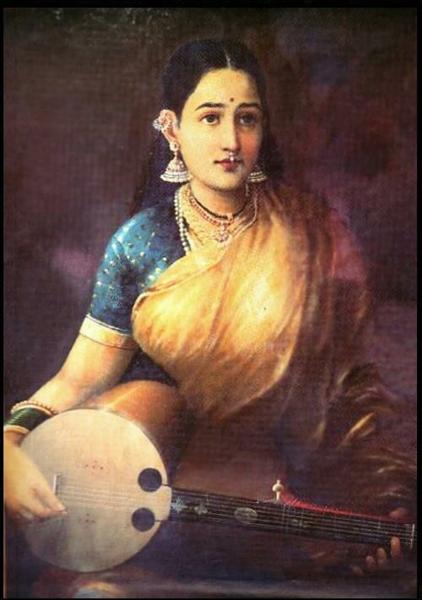Description
Rarely in art history we find such a sublime confluence of tradition and modernity as in Ravi Varma Raja works, and "Lady with Swarbat" (1874) is a perfect example of this delicate balance. Varma, a pioneer in Indian painting of the nineteenth century, merges Western influences in this masterpiece with the depth of Indian culture and aesthetics, creating a piece that is both a window to the past and a testimony of the transforming power of art .
The central figure of "Lady with Swarbat" is a young woman, elegantly dressed in a Sari rich in details and textures that speak of a meticulous craft. His position is relaxed, in an atmosphere of contemplation, while holding a swarbat a traditional musical instrument of India. This detail is crucial, since Swarbat not only adds a layer of cultural authenticity, but also suggests an intimate connection with the world of music and art beyond the canvas. The position of his hands and the inclination of his head denote serenity and an internal space rich in emotions.
The composition of the work is characterized by its simplicity and balance. Varma places the woman in the center, focusing the viewer's attention in her figure. This choice not only highlights its importance, but also allows reading without distractions, where every detail becomes a narrative itself. The bottom, although simple, suggests a well decorated interior, hinting at an environment of a certain opulence. The finely detailed curtains, the cushions, and the ground with their subtle pattern, complement and accentuate the richness of the protagonist's clothing, creating a captivating visual harmony.
In chromatic terms, Varma opts for a rich and deep color palette, with golden, blue and red tones that are mixed naturally, granting warmth and vitality to the scene. These colors are not mere visual ornaments, but they help contextualize the work within a cultural tradition marked by opulence and symbolism. The young woman's skin, represented with meticulous precision and warm tones, contrasts with bright tissues, creating an impressive realism effect.
Ravi Varma Raja, known for his ability to combine European academic painting techniques with themes and characters of the Indian subcontinent, offers us with "Lady with Swarbat" a work that transcends time. His technical skill is evident in the texture of the tissues, in the serene expression of women and in the anatomical precision that confers life and presence to the figure.
It is also relevant to highlight the perseverance of Varma in revaluing and dignifying indigenous cultural identities and expressions through their art. In a time of colonial domination, his work was not only innovative in aesthetic terms, but also an act of cultural resistance. When portraying female figures with dignity and depth, Ravi varams challenged the stereotyped and superficial representations of India and its people, promoting a more human and respectful vision.
"Lady with Swarbat" is, then, more than a simple painting; It is a mirror in which the complexity of identity, art and history are reflected. This work not only invites aesthetic contemplation, but also encourages a deep reflection on the rich cultural tapestry of India of the nineteenth century and the unwavering role of art in the preservation and celebration of that inheritance.
KUADROS ©, a famous paint on your wall.
Hand-made oil painting reproductions, with the quality of professional artists and the distinctive seal of KUADROS ©.
Art reproduction service with satisfaction guarantee. If you are not completely satisfied with the replica of your painting, we refund your money 100%.

